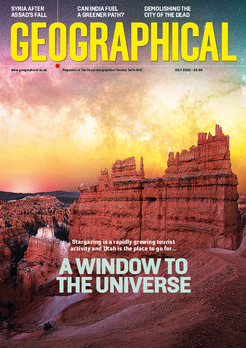
In his new book, Exploring the World, Alexander Maitland tells the inspiring tales of the 70-plus intrepid individuals who have received the Royal Geographical Society’s gold medal
Book of the month
Review by Olivia Edward
‘I am prepared to go anywhere, provided it is forward.’ This quote from David Livingstone could be applied to many of those who appear in Alexander Maitland’s new book, which covers 70-plus recipients of the Royal Geographical Society’s gold medals: the Founder’s and Patron’s medals.
Originally bestowed as a premium for the encouragement and promotion of geographical science and discoveries, the award was initially a sum of 50 guineas, first made in 1831, a year after the Society was formed; by 1839, it had morphed into the two separate gold medals that are now handed out annually, and which still require royal approval.
The resulting roll call of recipients reads like a who’s who of exploration. Nearly all of the men and women covered are worthy of a book in their own right, and many of the big names are here: Richard Burton, David Livingstone, Colonel Percy Fawcett, Alfred Russel Wallace, Eric Shipton, Gertrude Bell and Dame Freya Stark.
What emerges as the tales layer up is the inspiring singularity of so many of these intrepid individuals. They aren’t all high-achieving head girl/boy types, but instead come across as often unconventional and intractable, occasionally irrational, but nearly always resolute, even in their aberrance.
Many of them overcame considerable odds. Consider writer and Middle East explorer Stark, whose hair was dragged into a mechanical loom at her mother’s silk mill when she was 13, causing her to lose an ear, part of an eyelid and half of her scalp. Or Vilhjalmur Stefansson, an Icelandic-Canadian who spent four years in the Arctic with a fellow student living off rotten whale meat, ptarmigan feathers, tea leaves, snowshoe lashings and anything else that might provide them with a semblance of nourishment, without any contact or support from the outside world.
Their suffering often had an underlying purpose. Stefansson would go on to become a passionate advocate of the Inuit diet, claiming that after years living on meat and boiled fish washed down with nothing but cold water he had never been healthier. At the other end of the globe, Edward Wilson, Apsley Cherry-Garrard and Henry ‘Birdie’ Bowers went on ‘the weirdest bird’s nesting expedition that has ever been or ever will be’ in the hope of using the eggs of the emperor penguin to prove that there was a link between reptiles and birds (it was thought at the time that as embryos developed, they revealed their species’ evolutionary history – a belief that has since been disproved – and that the eggs of this ‘primitive’ bird would thus show their relationship with the dinosaurs). The expeditioners trudged more than 100 kilometres in temperatures that dropped as low as –60°C. Cherry-Garrard’s teeth cracked because they were chattering so violently and they all had to have their clothes cut from their bodies when they returned to camp. But the shell of one of the three eggs collected remains one of the Natural History Museum’s most hallowed treasures and Cherry-Garrard’s veracious account of the wider expedition, The Worst Journey in the World, hasn’t been out of print since.
Amid the tales of derring-do, elements of the surrounding culture ocasionally seep through, such as the Victorians’ growing interest in spiritualism and psychic mediums. When Lady Franklin’s husband disappeared searching for the Northwest Passage – a then mythical route that would cut thousands of miles off the sea journey between Europe and Asia – during the mid-1840s, she consulted various young women who were believed to possess psychic powers, even going so far as to direct the search for her missing husband based on directions purportedly provided by the sibyllic ghost of a three-year-old victim of gastric fever called Louisa (Weesy for short), who appeared to her family as a ‘ball of bluish light’.
Here and there, Maitland touches upon the moral complexities of exploration – eschewing the word ‘discovery’, except in the case of the Antarctic and acknowledging that naked commerce often acted as a powerful incentive for voyages and expeditions – but present behind the more dubious elements of various missions is the slow, inexorable layering up of knowledge, via various cul-de-sacs and endless bouts of illness, long years away from homes and families, days of hunger and exhaustion, and sometimes ships crushed in polar ice.
In the midst of all the hardships can sometimes be gleaned small, touching moments of compassion and humanity, such as the letters that Captain Robert Falcon Scott wrote to the families of his comrades Bowers and Wilson as they lay foredone and dying in a tent on their return from a failed quest to be first to reach the South Pole. To Mrs Wilson he wrote: ‘If this letter reaches you, Bill and I will have gone out together… He is not suffering… His eyes have a comfortable blue look of hope and his mind is peaceful. My whole heart goes out to you in pity.’
And underlying all of the loss is all that has been gained, both in terms of supporting the Society’s founding purpose – to further geographical and scientific knowledge – and in terms of the myriad journeys and adventures that have been ‘spurred on by curiosity, wonder and the pursuit of learning’.




